Paper Menu >>
Journal Menu >>
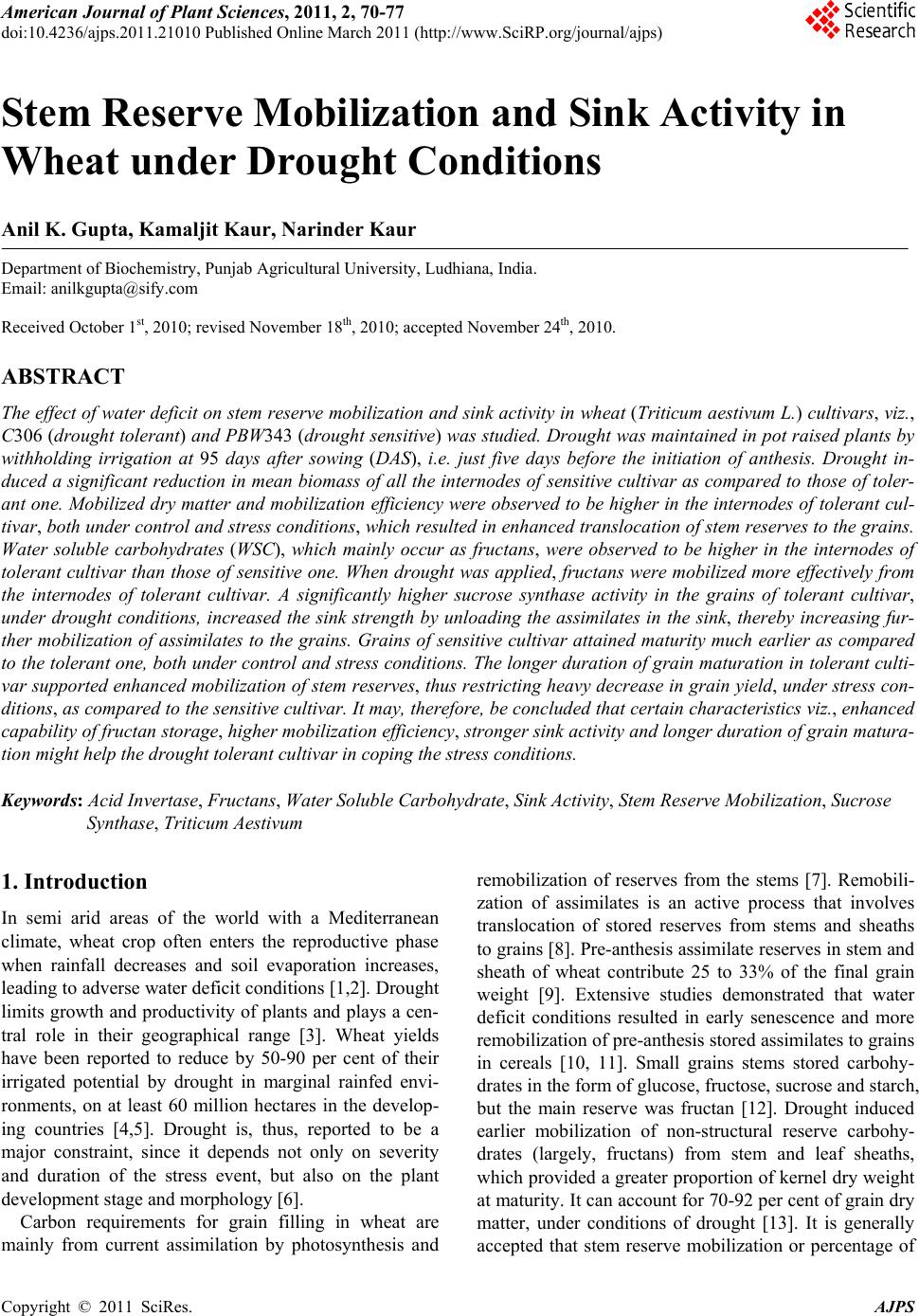 American Journal of Plant Sciences, 2011, 2, 70-77 doi:10.4236/ajps.2011.21010 Published Online March 2011 (http://www.SciRP.org/journal/ajps) Copyright © 2011 SciRes. AJPS Stem Reserve Mobilization and Sink Activity in Wheat under Drought Conditions Anil K. Gupta, Kamaljit Kaur, Narinder Kaur Department of Biochemistry, Punjab Agricultural University, Ludhiana, India. Email: anilkgupta@sify.com Received October 1st, 2010; revised November 18th, 2010; accepted November 24th, 2010. ABSTRACT The effect of water deficit on stem reserve mobilization and sink activity in wheat (Triticum aestivum L.) cu ltivars, viz., C306 (drought tolerant) and PBW343 (drough t sensitive) was studied. Drought was maintain ed in pot raised plants by withholding irrigation at 95 days after sowing (DAS), i.e. just five days before the initiation of anthesis. Drought in- duced a significan t reduction in mean biomass of all the in ternodes of sensitive cultivar as compared to those of toler- ant one. Mobilized dry matter and mob ilization efficiency were observed to be higher in the internodes of tolerant cul- tivar, both under control and stress conditions, which resulted in enh anced transloca tion of stem reserves to the grains. Water soluble carbohydrates (WSC), which mainly occur as fructans, were observed to be higher in the internodes of tolerant cultivar than those of sensitive one. When drought wa s applied, fructans were mob ilized more effectively from the internodes of tolerant cultivar. A significantly higher sucrose synthase activity in the grains of tolerant cultivar, under drought conditions, increased the sink strength by unloading the assimilates in the sink, thereby increasing fur- ther mobilization of assimilates to the grains. Grains of sensitive cultivar attained maturity much earlier as compared to the tolerant one, both und er control and stress conditions. The longer duration of grain maturatio n in tolerant culti- var supported enhanced mobiliza tion of stem reserves, thus restricting heavy decrease in grain yield, under stress con- ditions, as compared to the sensitive cultiva r. It may, therefore, be concluded that certa in characteristics viz., enhanced capability of fructan storage, higher mo biliza tio n efficienc y, stronger sink ac tivity and longer du ratio n of grain matura- tion might help the drought tolerant cu ltivar in coping the stress conditions. Keywords: Acid Invertase, Fructans, Water Soluble Carbohydrate, Sink Activity, Stem Reserve Mobilization, Sucrose Synthase, Triticum Aestivum 1. Introduction In semi arid areas of the world with a Mediterranean climate, wheat crop often enters the reproductive phase when rainfall decreases and soil evaporation increases, leading to adverse water deficit conditions [1,2]. Drought limits growth and productivity of plants and plays a cen- tral role in their geographical range [3]. Wheat yields have been reported to reduce by 50-90 per cent of their irrigated potential by drought in marginal rainfed envi- ronments, on at least 60 million hectares in the develop- ing countries [4,5]. Drought is, thus, reported to be a major constraint, since it depends not only on severity and duration of the stress event, but also on the plant development stage and morphology [6]. Carbon requirements for grain filling in wheat are mainly from current assimilation by photosynthesis and remobilization of reserves from the stems [7]. Remobili- zation of assimilates is an active process that involves translocation of stored reserves from stems and sheaths to grains [8]. Pre-anthesis assimilate reserves in stem and sheath of wheat contribute 25 to 33% of the final grain weight [9]. Extensive studies demonstrated that water deficit conditions resulted in early senescence and more remobilization of pre-anthesis stored assimilates to grains in cereals [10, 11]. Small grains stems stored carbohy- drates in the form of glucose, fructose, sucrose and starch, but the main reserve was fructan [12]. Drought induced earlier mobilization of non-structural reserve carbohy- drates (largely, fructans) from stem and leaf sheaths, which provided a greater proportion of kernel dry weight at maturity. It can account for 70-92 per cent of grain dry matter, under conditions of drought [13]. It is generally accepted that stem reserve mobilization or percentage of 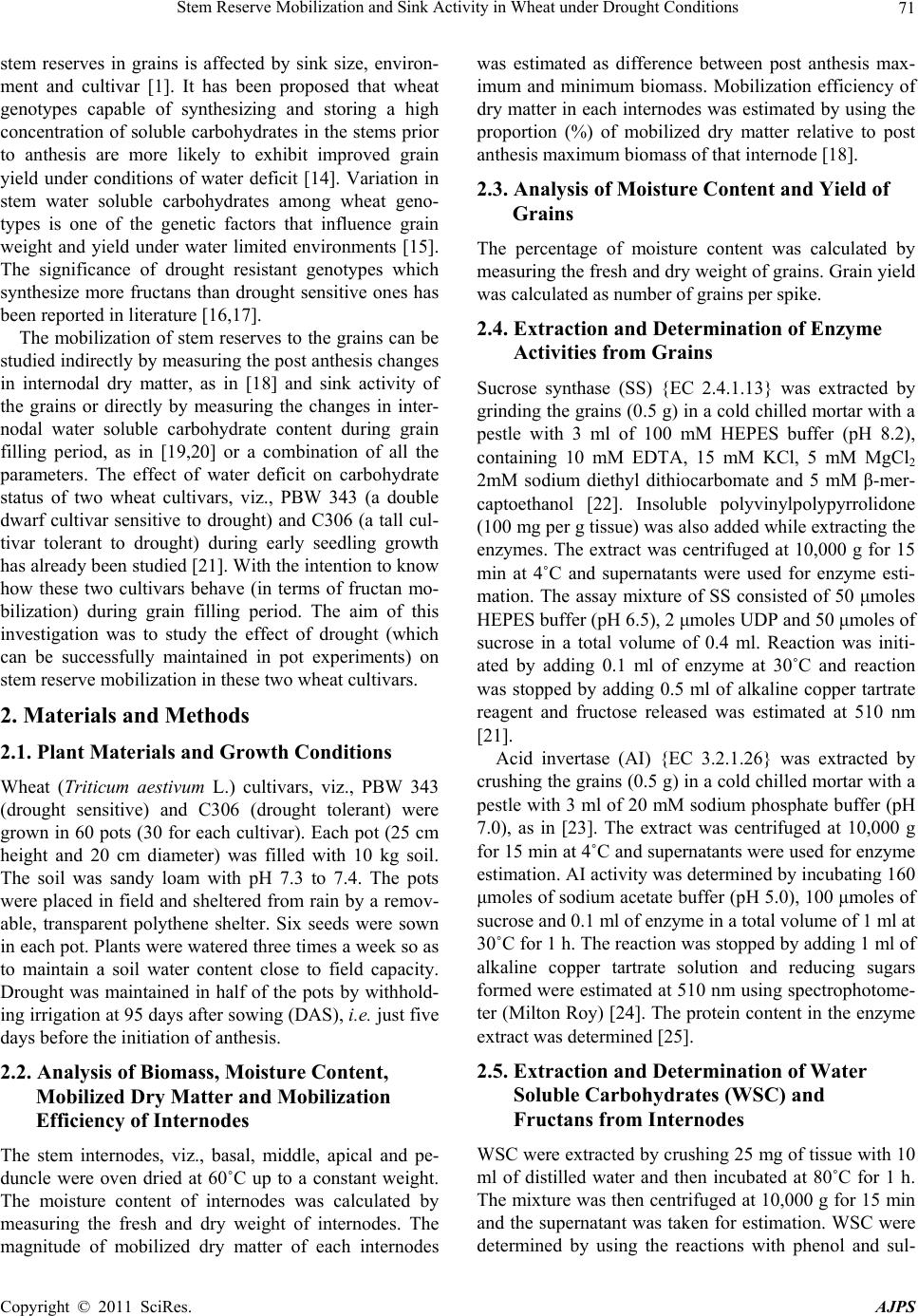 Stem Reserve Mobilization and Sink Activity in Wheat under Drought Conditions Copyright © 2011 SciRes. AJPS 71 stem reserves in grains is affected by sink size, environ- ment and cultivar [1]. It has been proposed that wheat genotypes capable of synthesizing and storing a high concentration of soluble carbohydrates in the stems prior to anthesis are more likely to exhibit improved grain yield under conditions of water deficit [14]. Variation in stem water soluble carbohydrates among wheat geno- types is one of the genetic factors that influence grain weight and yield under water limited environments [15]. The significance of drought resistant genotypes which synthesize more fructans than drought sensitive ones has been reported in literature [16,17]. The mobilization of stem reserves to the grains can be studied indirectly by measuring the post anthesis changes in internodal dry matter, as in [18] and sink activity of the grains or directly by measuring the changes in inter- nodal water soluble carbohydrate content during grain filling period, as in [19,20] or a combination of all the parameters. The effect of water deficit on carbohydrate status of two wheat cultivars, viz., PBW 343 (a double dwarf cultivar sensitive to drought) and C306 (a tall cul- tivar tolerant to drought) during early seedling growth has already been studied [21]. With the intention to know how these two cultivars behave (in terms of fructan mo- bilization) during grain filling period. The aim of this investigation was to study the effect of drought (which can be successfully maintained in pot experiments) on stem reserve mobilization in these two wheat cultivars. 2. Materials and Methods 2.1. Plant Materials and Growth Conditions Wheat (Triticum aestivum L.) cultivars, viz., PBW 343 (drought sensitive) and C306 (drought tolerant) were grown in 60 pots (30 for each cultivar). Each pot (25 cm height and 20 cm diameter) was filled with 10 kg soil. The soil was sandy loam with pH 7.3 to 7.4. The pots were placed in field and sheltered from rain by a remov- able, transparent polythene shelter. Six seeds were sown in each pot. Plants were watered three times a week so as to maintain a soil water content close to field capacity. Drought was maintained in half of the pots by withhold- ing irrigation at 95 days after sowing (DAS), i.e. just five days before the initiation of anthesis. 2.2. Analysis of Biomass, Moisture Content, Mobilized Dry Matter and Mobilization Efficiency of Internodes The stem internodes, viz., basal, middle, apical and pe- duncle were oven dried at 60˚C up to a constant weight. The moisture content of internodes was calculated by measuring the fresh and dry weight of internodes. The magnitude of mobilized dry matter of each internodes was estimated as difference between post anthesis max- imum and minimum biomass. Mobilization efficiency of dry matter in each internodes was estimated by using the proportion (%) of mobilized dry matter relative to post anthesis maximum biomass of that internode [18]. 2.3. Analysis of Moisture Content and Yield of Grains The percentage of moisture content was calculated by measuring the fresh and dry weight of grains. Grain yield was calculated as number of grains per spike. 2.4. Extraction and Determination of Enzyme Activities from Grains Sucrose synthase (SS) {EC 2.4.1.13} was extracted by grinding the grains (0.5 g) in a cold chilled mortar with a pestle with 3 ml of 100 mM HEPES buffer (pH 8.2), containing 10 mM EDTA, 15 mM KCl, 5 mM MgCl2 2mM sodium diethyl dithiocarbomate and 5 mM β-mer- captoethanol [22]. Insoluble polyvinylpolypyrrolidone (100 mg per g tissue) was also added while extracting the enzymes. The extract was centrifuged at 10,000 g for 15 min at 4˚C and supernatants were used for enzyme esti- mation. The assay mixture of SS consisted of 50 μmoles HEPES buffer (pH 6.5), 2 μmoles UDP and 50 μmoles of sucrose in a total volume of 0.4 ml. Reaction was initi- ated by adding 0.1 ml of enzyme at 30˚C and reaction was stopped by adding 0.5 ml of alkaline copper tartrate reagent and fructose released was estimated at 510 nm [21]. Acid invertase (AI) {EC 3.2.1.26} was extracted by crushing the grains (0.5 g) in a cold chilled mortar with a pestle with 3 ml of 20 mM sodium phosphate buffer (pH 7.0), as in [23]. The extract was centrifuged at 10,000 g for 15 min at 4˚C and supernatants were used for enzyme estimation. AI activity was determined by incubating 160 μmoles of sodium acetate buffer (pH 5.0), 100 μmoles of sucrose and 0.1 ml of enzyme in a total volume of 1 ml at 30˚C for 1 h. The reaction was stopped by adding 1 ml of alkaline copper tartrate solution and reducing sugars formed were estimated at 510 nm using spectrophotome- ter (Milton Roy) [24]. The protein content in the enzyme extract was determined [25]. 2.5. Extraction and Determination of Water Soluble Carbohydrates (WSC) and Fructans from Internodes WSC were extracted by crushing 25 mg of tissue with 10 ml of distilled water and then incubated at 80˚C for 1 h. The mixture was then centrifuged at 10,000 g for 15 min and the supernatant was taken for estimation. WSC were determined by using the reactions with phenol and sul-  Stem Reserve Mobilization and Sink Activity in Wheat under Drought Conditions Copyright © 2011 SciRes. AJPS 72 phuric acid [26]. Fructans were determined, after de- stroying free fructose by adding 0.5 ml of 30% NaOH to 0.5 ml of sugar extract and keeping the mixture in boiling water bath for 10 min. Thereafter fructans were estimated by using resorcinol and HCl [27]. 3. Results The effect of drought on stem reserve mobilization of PBW343 and C306 cultivars was studied by analyzing the dry matter and carbohydrate composition of inter- nodes along with sink activity of grains. 3.1. Effect of Drought on Biomass, Mobilized Dry Matter and Mobilization Efficiency of Inter Nodes Drought induced a significant reduction in the biomass of stem internodes of sensitive cultivar as compared to those of tolerant one (Table 1). The mean biomass of all the internodes of sensitive cultivar were reduced whereas only the apical and peduncle internodes of tolerant culti- var showed reduced mean biomass, under stress condi- tions. The stressed plants of sensitive cultivar showed higher reduction in the mean biomass of apical and pe- duncle internodes (52% and 61% respectively) than those of tolerant one, which showed only 33-36% decrease, when compared to their respective controls (Table 1). In addition, the mobilized dry matter of internodes and the differences between post anthesis maximum and mini- mum weight were higher in the tolerant cultivar as com- pared to the sensitive one, both under control as well as stress conditions. Mobilization efficiency of dry matter, estimated as the ratio of mobilized dry matter to maxi- mum weight was also higher in all the internodes of tol- erant cultivar than that of sensitive one, under both con- trol and drought conditions (Table 1). The peduncle in- ternodes of tolerant cultivar showed the maximum mobi- lization efficiency under drought conditions (Table 1). 3.2. Effect of Drought on Moisture Content of Internodes The data on the percentage of moisture content of inter- nodes showed that drought caused in higher mobilization of stem reserves, particularly from the upper internodes (apical and peduncle) of tolerant cultivar as compared to those of sensitive one (Table 2). 3.3. Effect of Drought on Moisture Content and Yield of Grains The analysis of grain moisture content showed that the sensitive cultivar attained maturity much earlier com- pared to the tolerant one, under both control and stress conditions (Table 3). Mean grain yield of sensitive cul- tivar was 32.5 ± 2.0 and 18.5 ± 2.1 for control and stressed plants respectively. The tolerant cultivar had 25.7 ± 1.3 and 19.0 ± 1.7 grains per spike for control and stressed plants respectively. Drought induced approxi- mately 43% decrease in grain yield (number of grains per spike) of sensitive cultivar and 26% decrease in grain yield of tolerant one when compared each cultivar with own respective control. Table 1. Effect of withholding irrigation at 95 DAS stage on biomass (mg, mobilized dry matter (mg) and mobilization effi- ciency (ME) of stem internodes of PBW 343 and C306 cultivars. PBW343 C306 Days after anthesis Basal Middle Apical Peduncle Basal Middle Apical Peduncle 0 115 ± 18 (95 ± 12) 124 ± 20 (72 ± 10) 125 ± 12 (63 ± 7) 122 ± 14 (52 ± 10) 150 ± 10 (132 ± 11) 111 ± 30 (133 ± 13) 153 ± 21 (113 ± 20) 123 ± 10 (115 ± 20) 7 112 ± 20 (94 ± 10) 142 ± 30 (80 ± 12) 183 ± 24 (75 ± 21) 135 ± 32 (50 ± 12) 162 ± 18 (127 ± 10) 163 ± 13 (125 ± 20) 184 ± 24 (90 ± 9) 200 ± 30 (100 ± 21) 14 109 ± 29 (90 ± 15) 130 ± 15 (77 ± 13) 145 ± 19 (73 ± 19) 127 ± 13 (48 ± 10) 92 ± 12 (123 ± 14) 112 ± 15 (117 ± 14) 133 ± 30 (85 ± 12) 132 ± 15 (89 ± 11) 28 95 ± 16 (85 ± 12) 110 ± 12 (68 ± 7) 128 ± 22 (67 ± 20) 112 ± 21 (43 ± 9) 80 ± 13 (108 ± 21) 84 ± 6 (98 ± 10) 115 ± 10 (77 ± 11) 105 ± 9 (68 ± 10) 42 81 ± 10 (82 ± 9) 101 ± 11 (63 ± 10) 120 ± 10 (60 ± 10) 100 ± 15 (40 ± 7) 70 ± 10 (101 ± 17) 62 ± 12 (72 ± 10) 91 ± 11 (70 ± 13) 80 ± 9 (53 ± 13) Mean Biomass 100 (88) 118 (71) 137 (67) 117 (45) 102 (116) 100 (105) 129 (84) 121 (80) Mobilized dry matter 34 (13) 41 (17) 63 (15) 35 (12) 92 (31) 101 (61) 93 (43) 120 (62) ME (%) 29.6 (13.7) 28.9 (21.2) 34.4 (20.0) 25.9 (23.1) 56.8 (23.5) 62.0 (45.9) 50.5 (38.0) 60.0 (53.0) Data represent mean ± S.D. of four replicates. Values without parentheses are for control plants and those with parentheses are for water deficit plants. 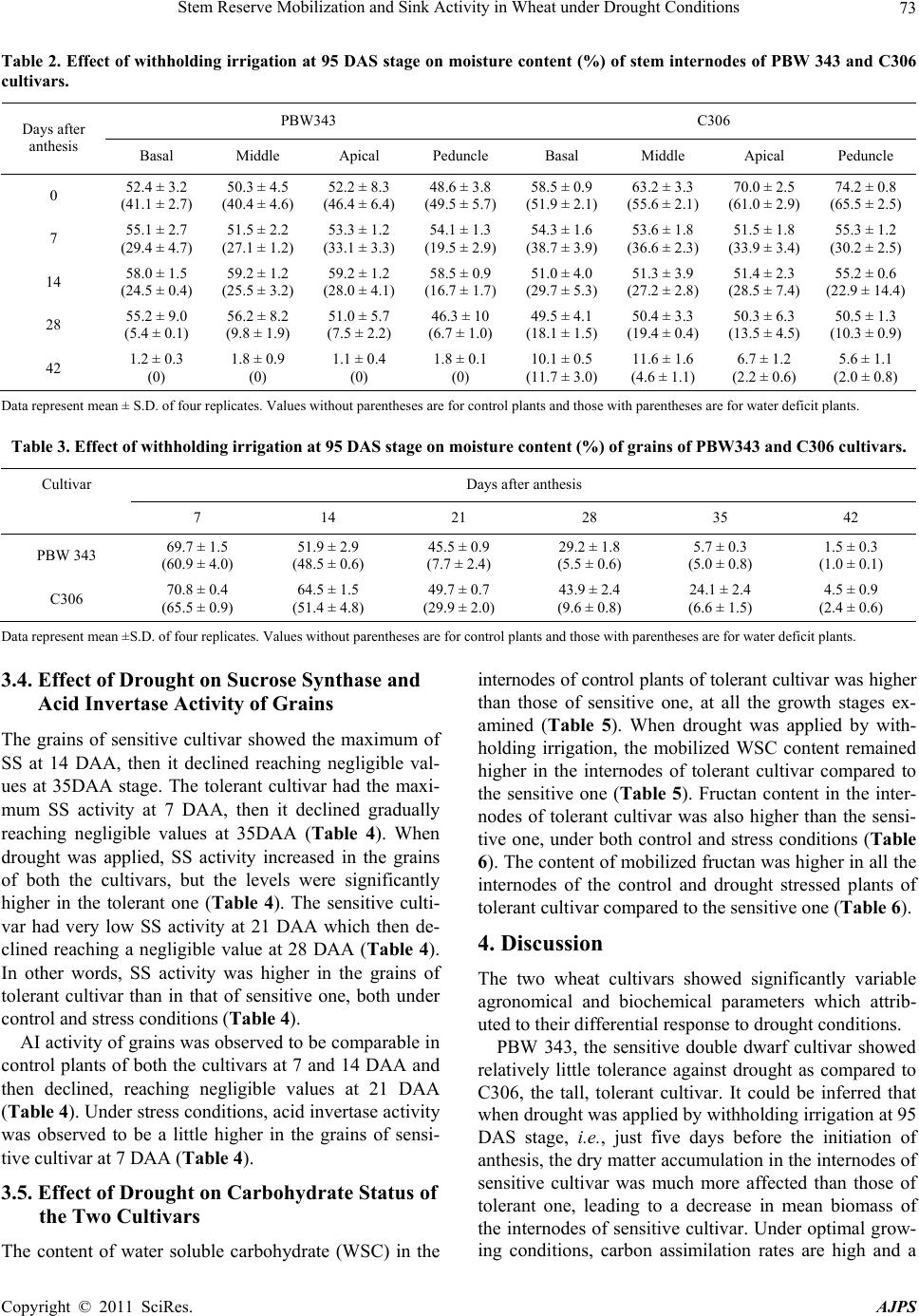 Stem Reserve Mobilization and Sink Activity in Wheat under Drought Conditions Copyright © 2011 SciRes. AJPS 73 Table 2. Effect of withholding irrigation at 95 DAS stage on moisture content (%) of stem internodes of PBW 343 and C306 cultivars. PBW343 C306 Days after anthesis Basal Middle Apical Peduncle Basal Middle Apical Peduncle 0 52.4 ± 3.2 (41.1 ± 2.7) 50.3 ± 4.5 (40.4 ± 4.6) 52.2 ± 8.3 (46.4 ± 6.4) 48.6 ± 3.8 (49.5 ± 5.7) 58.5 ± 0.9 (51.9 ± 2.1) 63.2 ± 3.3 (55.6 ± 2.1) 70.0 ± 2.5 (61.0 ± 2.9) 74.2 ± 0.8 (65.5 ± 2.5) 7 55.1 ± 2.7 (29.4 ± 4.7) 51.5 ± 2.2 (27.1 ± 1.2) 53.3 ± 1.2 (33.1 ± 3.3) 54.1 ± 1.3 (19.5 ± 2.9) 54.3 ± 1.6 (38.7 ± 3.9) 53.6 ± 1.8 (36.6 ± 2.3) 51.5 ± 1.8 (33.9 ± 3.4) 55.3 ± 1.2 (30.2 ± 2.5) 14 58.0 ± 1.5 (24.5 ± 0.4) 59.2 ± 1.2 (25.5 ± 3.2) 59.2 ± 1.2 (28.0 ± 4.1) 58.5 ± 0.9 (16.7 ± 1.7) 51.0 ± 4.0 (29.7 ± 5.3) 51.3 ± 3.9 (27.2 ± 2.8) 51.4 ± 2.3 (28.5 ± 7.4) 55.2 ± 0.6 (22.9 ± 14.4) 28 55.2 ± 9.0 (5.4 ± 0.1) 56.2 ± 8.2 (9.8 ± 1.9) 51.0 ± 5.7 (7.5 ± 2.2) 46.3 ± 10 (6.7 ± 1.0) 49.5 ± 4.1 (18.1 ± 1.5) 50.4 ± 3.3 (19.4 ± 0.4) 50.3 ± 6.3 (13.5 ± 4.5) 50.5 ± 1.3 (10.3 ± 0.9) 42 1.2 ± 0.3 (0) 1.8 ± 0.9 (0) 1.1 ± 0.4 (0) 1.8 ± 0.1 (0) 10.1 ± 0.5 (11.7 ± 3.0) 11.6 ± 1.6 (4.6 ± 1.1) 6.7 ± 1.2 (2.2 ± 0.6) 5.6 ± 1.1 (2.0 ± 0.8) Data represent mean ± S.D. of four replicates. Values without parentheses are for control plants and those with parentheses are for water deficit plants. Table 3. Effect of withholding irrigation at 95 DAS stage on moisture content (%) of grains of PBW343 and C306 cultivars. Cultivar Days after anthesis 7 14 21 28 35 42 PBW 343 69.7 ± 1.5 (60.9 ± 4.0) 51.9 ± 2.9 (48.5 ± 0.6) 45.5 ± 0.9 (7.7 ± 2.4) 29.2 ± 1.8 (5.5 ± 0.6) 5.7 ± 0.3 (5.0 ± 0.8) 1.5 ± 0.3 (1.0 ± 0.1) C306 70.8 ± 0.4 (65.5 ± 0.9) 64.5 ± 1.5 (51.4 ± 4.8) 49.7 ± 0.7 (29.9 ± 2.0) 43.9 ± 2.4 (9.6 ± 0.8) 24.1 ± 2.4 (6.6 ± 1.5) 4.5 ± 0.9 (2.4 ± 0.6) Data represent mean ±S.D. of four replicates. Values without parentheses are for control plants and those with parentheses are for water deficit plants. 3.4. Effect of Drought on Sucrose Synthase and Acid Invertase Activity of Grains The grains of sensitive cultivar showed the maximum of SS at 14 DAA, then it declined reaching negligible val- ues at 35DAA stage. The tolerant cultivar had the maxi- mum SS activity at 7 DAA, then it declined gradually reaching negligible values at 35DAA (Table 4). When drought was applied, SS activity increased in the grains of both the cultivars, but the levels were significantly higher in the tolerant one (Table 4). The sensitive culti- var had very low SS activity at 21 DAA which then de- clined reaching a negligible value at 28 DAA (Table 4). In other words, SS activity was higher in the grains of tolerant cultivar than in that of sensitive one, both under control and stress conditions (Table 4). AI activity of grains was observed to be comparable in control plants of both the cultivars at 7 and 14 DAA and then declined, reaching negligible values at 21 DAA (Table 4). Under stress conditions, acid invertase activity was observed to be a little higher in the grains of sensi- tive cultivar at 7 DAA (Table 4). 3.5. Effect of Drought on Carbohydrate Status of the Two Cultivars The content of water soluble carbohydrate (WSC) in the internodes of control plants of tolerant cultivar was higher than those of sensitive one, at all the growth stages ex- amined (Table 5). When drought was applied by with- holding irrigation, the mobilized WSC content remained higher in the internodes of tolerant cultivar compared to the sensitive one (Table 5). Fructan content in the inter- nodes of tolerant cultivar was also higher than the sensi- tive one, under both control and stress conditions (Table 6). The content of mobilized fructan was higher in all the internodes of the control and drought stressed plants of tolerant cultivar compared to the sensitive one (Table 6). 4. Discussion The two wheat cultivars showed significantly variable agronomical and biochemical parameters which attrib- uted to their differential response to drought conditions. PBW 343, the sensitive double dwarf cultivar showed relatively little tolerance against drought as compared to C306, the tall, tolerant cultivar. It could be inferred that when drought was applied by withholding irrigation at 95 DAS stage, i.e., just five days before the initiation of anthesis, the dry matter accumulation in the internodes of sensitive cultivar was much more affected than those of tolerant one, leading to a decrease in mean biomass of the internodes of sensitive cultivar. Under optimal grow- ing conditions, carbon assimilation rates are high and a 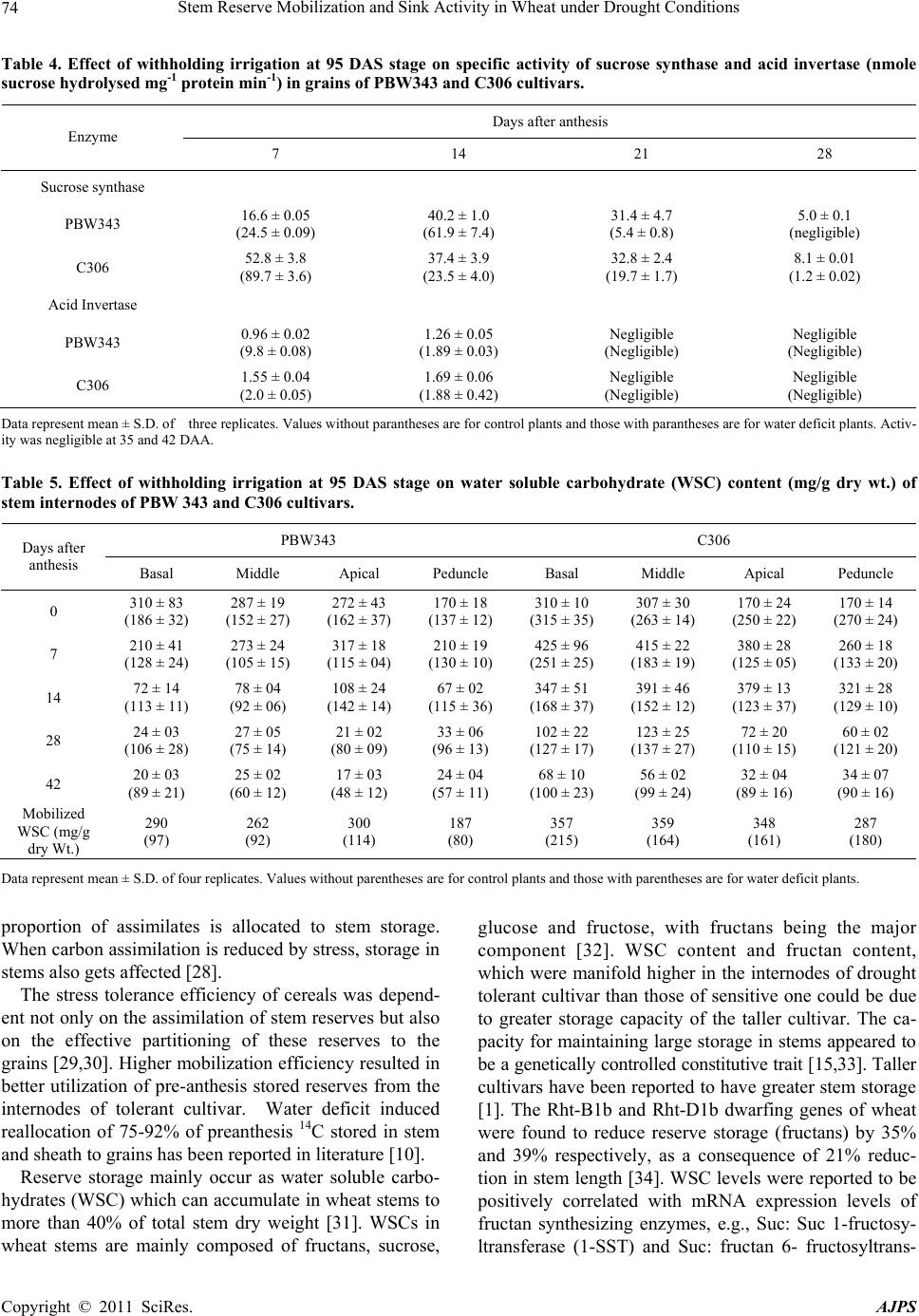 Stem Reserve Mobilization and Sink Activity in Wheat under Drought Conditions Copyright © 2011 SciRes. AJPS 74 Table 4. Effect of withholding irrigation at 95 DAS stage on specific activity of sucrose synthase and acid invertase (nmole sucrose hydrolysed mg-1 protein min-1) in grains of PBW343 and C306 cultivars. Days after anthesis Enzyme 7 14 21 28 Sucrose synthase PBW343 16.6 ± 0.05 (24.5 ± 0.09) 40.2 ± 1.0 (61.9 ± 7.4) 31.4 ± 4.7 (5.4 ± 0.8) 5.0 ± 0.1 (negligible) C306 52.8 ± 3.8 (89.7 ± 3.6) 37.4 ± 3.9 (23.5 ± 4.0) 32.8 ± 2.4 (19.7 ± 1.7) 8.1 ± 0.01 (1.2 ± 0.02) Acid Invertase PBW343 0.96 ± 0.02 (9.8 ± 0.08) 1.26 ± 0.05 (1.89 ± 0.03) Negligible (Negligible) Negligible (Negligible) C306 1.55 ± 0.04 (2.0 ± 0.05) 1.69 ± 0.06 (1.88 ± 0.42) Negligible (Negligible) Negligible (Negligible) Data represent mean ± S.D. of three replicates. Values without parantheses are for control plants and those with parantheses are for water deficit plants. Activ- ity was negligible at 35 and 42 DAA. Table 5. Effect of withholding irrigation at 95 DAS stage on water soluble carbohydrate (WSC) content (mg/g dry wt.) of stem internodes of PBW 343 and C306 cultivars. PBW343 C306 Days after anthesis Basal Middle Apical Peduncle Basal Middle Apical Peduncle 0 310 ± 83 (186 ± 32) 287 ± 19 (152 ± 27) 272 ± 43 (162 ± 37) 170 ± 18 (137 ± 12) 310 ± 10 (315 ± 35) 307 ± 30 (263 ± 14) 170 ± 24 (250 ± 22) 170 ± 14 (270 ± 24) 7 210 ± 41 (128 ± 24) 273 ± 24 (105 ± 15) 317 ± 18 (115 ± 04) 210 ± 19 (130 ± 10) 425 ± 96 (251 ± 25) 415 ± 22 (183 ± 19) 380 ± 28 (125 ± 05) 260 ± 18 (133 ± 20) 14 72 ± 14 (113 ± 11) 78 ± 04 (92 ± 06) 108 ± 24 (142 ± 14) 67 ± 02 (115 ± 36) 347 ± 51 (168 ± 37) 391 ± 46 (152 ± 12) 379 ± 13 (123 ± 37) 321 ± 28 (129 ± 10) 28 24 ± 03 (106 ± 28) 27 ± 05 (75 ± 14) 21 ± 02 (80 ± 09) 33 ± 06 (96 ± 13) 102 ± 22 (127 ± 17) 123 ± 25 (137 ± 27) 72 ± 20 (110 ± 15) 60 ± 02 (121 ± 20) 42 20 ± 03 (89 ± 21) 25 ± 02 (60 ± 12) 17 ± 03 (48 ± 12) 24 ± 04 (57 ± 11) 68 ± 10 (100 ± 23) 56 ± 02 (99 ± 24) 32 ± 04 (89 ± 16) 34 ± 07 (90 ± 16) Mobilized WSC (mg/g dry Wt.) 290 (97) 262 (92) 300 (114) 187 (80) 357 (215) 359 (164) 348 (161) 287 (180) Data represent mean ± S.D. of four replicates. Values without parentheses are for control plants and those with parentheses are for water deficit plants. proportion of assimilates is allocated to stem storage. When carbon assimilation is reduced by stress, storage in stems also gets affected [28]. The stress tolerance efficiency of cereals was depend- ent not only on the assimilation of stem reserves but also on the effective partitioning of these reserves to the grains [29,30]. Higher mobilization efficiency resulted in better utilization of pre-anthesis stored reserves from the internodes of tolerant cultivar. Water deficit induced reallocation of 75-92% of preanthesis 14C stored in stem and sheath to grains has been reported in literature [10]. Reserve storage mainly occur as water soluble carbo- hydrates (WSC) which can accumulate in wheat stems to more than 40% of total stem dry weight [31]. WSCs in wheat stems are mainly composed of fructans, sucrose, glucose and fructose, with fructans being the major component [32]. WSC content and fructan content, which were manifold higher in the internodes of drought tolerant cultivar than those of sensitive one could be due to greater storage capacity of the taller cultivar. The ca- pacity for maintaining large storage in stems appeared to be a genetically controlled constitutive trait [15,33]. Taller cultivars have been reported to have greater stem storage [1]. The Rht-B1b and Rht-D1b dwarfing genes of wheat were found to reduce reserve storage (fructans) by 35% and 39% respectively, as a consequence of 21% reduc- tion in stem length [34]. WSC levels were reported to be positively correlated with mRNA expression levels of fructan synthesizing enzymes, e.g., Suc: Suc 1-fructosy- ltransferase (1-SST) and Suc: fructan 6- fructosyltrans- 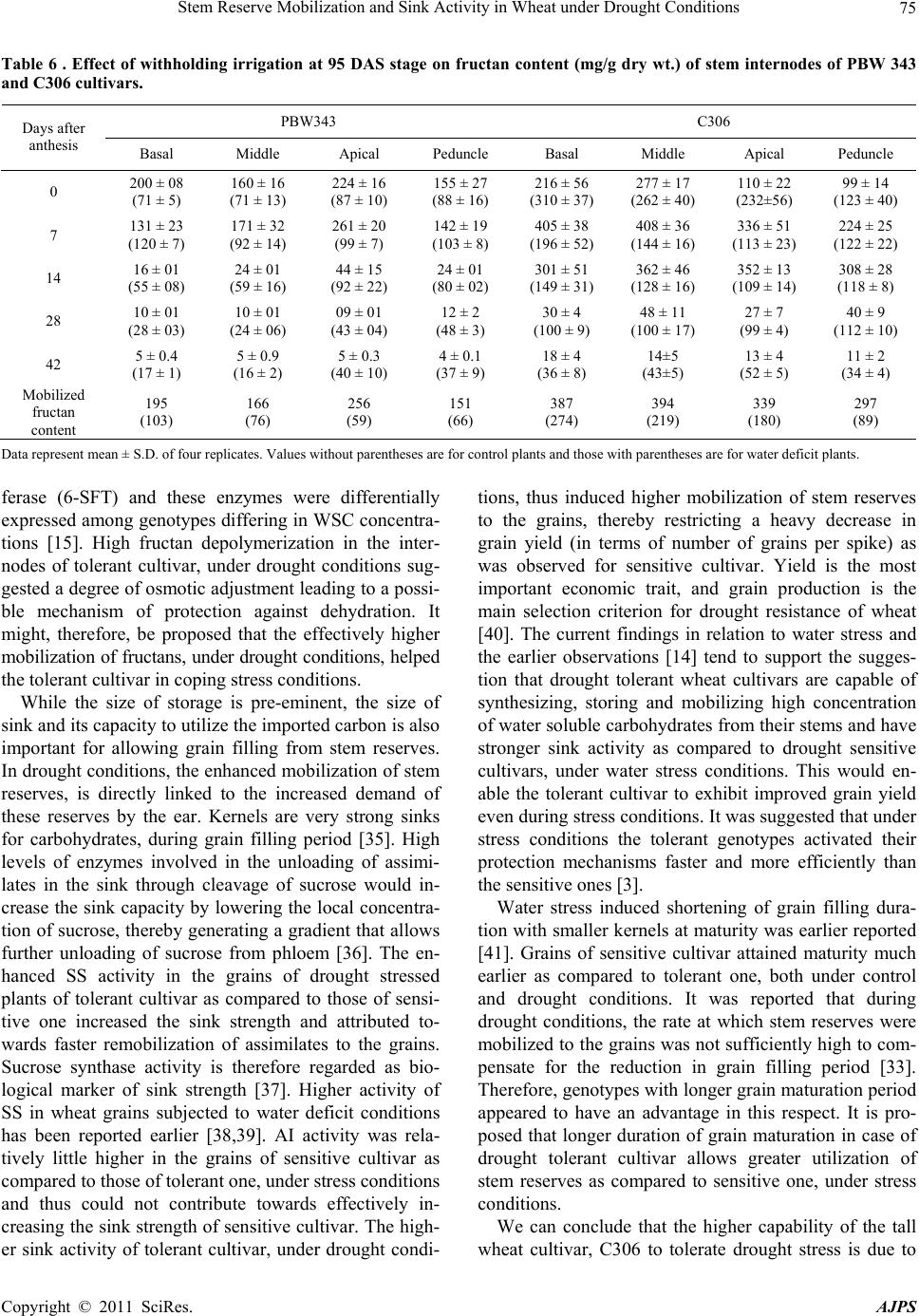 Stem Reserve Mobilization and Sink Activity in Wheat under Drought Conditions Copyright © 2011 SciRes. AJPS 75 Table 6 . Effect of withholding irrigation at 95 DAS stage on fructan content (mg/g dry wt.) of stem internodes of PBW 343 and C306 cultivars. PBW343 C306 Days after anthesis Basal Middle Apical Peduncle Basal Middle Apical Peduncle 0 200 ± 08 (71 ± 5) 160 ± 16 (71 ± 13) 224 ± 16 (87 ± 10) 155 ± 27 (88 ± 16) 216 ± 56 (310 ± 37) 277 ± 17 (262 ± 40) 110 ± 22 (232±56) 99 ± 14 (123 ± 40) 7 131 ± 23 (120 ± 7) 171 ± 32 (92 ± 14) 261 ± 20 (99 ± 7) 142 ± 19 (103 ± 8) 405 ± 38 (196 ± 52) 408 ± 36 (144 ± 16) 336 ± 51 (113 ± 23) 224 ± 25 (122 ± 22) 14 16 ± 01 (55 ± 08) 24 ± 01 (59 ± 16) 44 ± 15 (92 ± 22) 24 ± 01 (80 ± 02) 301 ± 51 (149 ± 31) 362 ± 46 (128 ± 16) 352 ± 13 (109 ± 14) 308 ± 28 (118 ± 8) 28 10 ± 01 (28 ± 03) 10 ± 01 (24 ± 06) 09 ± 01 (43 ± 04) 12 ± 2 (48 ± 3) 30 ± 4 (100 ± 9) 48 ± 11 (100 ± 17) 27 ± 7 (99 ± 4) 40 ± 9 (112 ± 10) 42 5 ± 0.4 (17 ± 1) 5 ± 0.9 (16 ± 2) 5 ± 0.3 (40 ± 10) 4 ± 0.1 (37 ± 9) 18 ± 4 (36 ± 8) 14±5 (43±5) 13 ± 4 (52 ± 5) 11 ± 2 (34 ± 4) Mobilized fructan content 195 (103) 166 (76) 256 (59) 151 (66) 387 (274) 394 (219) 339 (180) 297 (89) Data represent mean ± S.D. of four replicates. Values without parentheses are for control plants and those with parentheses are for water deficit plants. ferase (6-SFT) and these enzymes were differentially expressed among genotypes differing in WSC concentra- tions [15]. High fructan depolymerization in the inter- nodes of tolerant cultivar, under drought conditions sug- gested a degree of osmotic adjustment leading to a possi- ble mechanism of protection against dehydration. It might, therefore, be proposed that the effectively higher mobilization of fructans, under drought conditions, helped the tolerant cultivar in coping stress conditions. While the size of storage is pre-eminent, the size of sink and its capacity to utilize the imported carbon is also important for allowing grain filling from stem reserves. In drought conditions, the enhanced mobilization of stem reserves, is directly linked to the increased demand of these reserves by the ear. Kernels are very strong sinks for carbohydrates, during grain filling period [35]. High levels of enzymes involved in the unloading of assimi- lates in the sink through cleavage of sucrose would in- crease the sink capacity by lowering the local concentra- tion of sucrose, thereby generating a gradient that allows further unloading of sucrose from phloem [36]. The en- hanced SS activity in the grains of drought stressed plants of tolerant cultivar as compared to those of sensi- tive one increased the sink strength and attributed to- wards faster remobilization of assimilates to the grains. Sucrose synthase activity is therefore regarded as bio- logical marker of sink strength [37]. Higher activity of SS in wheat grains subjected to water deficit conditions has been reported earlier [38,39]. AI activity was rela- tively little higher in the grains of sensitive cultivar as compared to those of tolerant one, under stress conditions and thus could not contribute towards effectively in- creasing the sink strength of sensitive cultivar. The high- er sink activity of tolerant cultivar, under drought condi- tions, thus induced higher mobilization of stem reserves to the grains, thereby restricting a heavy decrease in grain yield (in terms of number of grains per spike) as was observed for sensitive cultivar. Yield is the most important economic trait, and grain production is the main selection criterion for drought resistance of wheat [40]. The current findings in relation to water stress and the earlier observations [14] tend to support the sugges- tion that drought tolerant wheat cultivars are capable of synthesizing, storing and mobilizing high concentration of water soluble carbohydrates from their stems and have stronger sink activity as compared to drought sensitive cultivars, under water stress conditions. This would en- able the tolerant cultivar to exhibit improved grain yield even during stress conditions. It was suggested that under stress conditions the tolerant genotypes activated their protection mechanisms faster and more efficiently than the sensitive ones [3]. Water stress induced shortening of grain filling dura- tion with smaller kernels at maturity was earlier reported [41]. Grains of sensitive cultivar attained maturity much earlier as compared to tolerant one, both under control and drought conditions. It was reported that during drought conditions, the rate at which stem reserves were mobilized to the grains was not sufficiently high to com- pensate for the reduction in grain filling period [33]. Therefore, genotypes with longer grain maturation period appeared to have an advantage in this respect. It is pro- posed that longer duration of grain maturation in case of drought tolerant cultivar allows greater utilization of stem reserves as compared to sensitive one, under stress conditions. We can conclude that the higher capability of the tall wheat cultivar, C306 to tolerate drought stress is due to 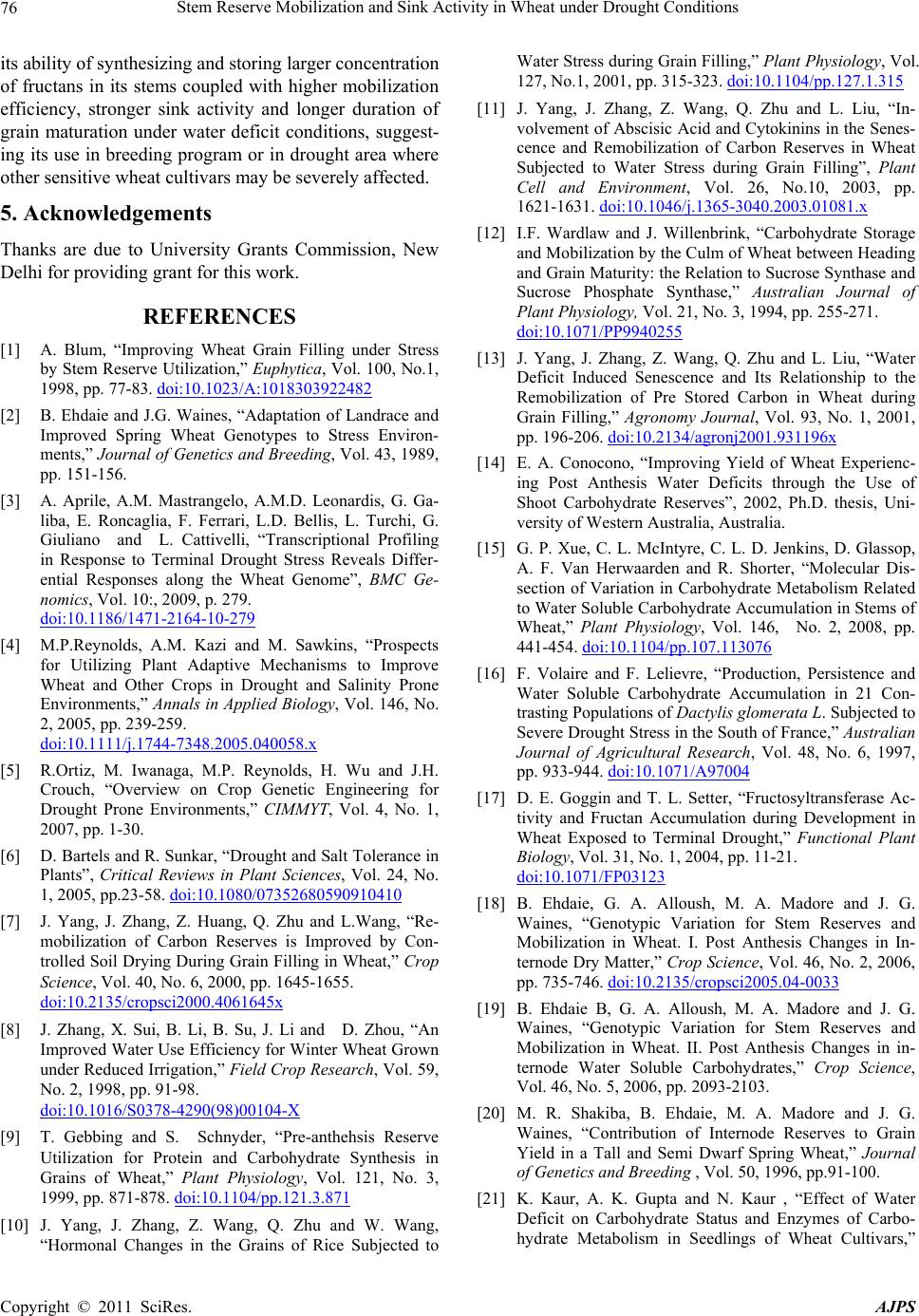 Stem Reserve Mobilization and Sink Activity in Wheat under Drought Conditions Copyright © 2011 SciRes. AJPS 76 its ability of synthesizing and storing larger concentration of fructans in its stems coupled with higher mobilization efficiency, stronger sink activity and longer duration of grain maturation under water deficit conditions, suggest- ing its use in breeding program or in drought area where other sensitive wheat cultivars may be severely affected. 5. Acknowledgements Thanks are due to University Grants Commission, New Delhi for providing grant for this work. REFERENCES [1] A. Blum, “Improving Wheat Grain Filling under Stress by Stem Reserve Utilization,” Euphytica, Vol. 100, No.1, 1998, pp. 77-83. doi:10.1023/A:1018303922482 [2] B. Ehdaie and J.G. Waines, “Adaptation of Landrace and Improved Spring Wheat Genotypes to Stress Environ- ments,” Journal of Genetics and Breeding, Vol. 43, 1989, pp. 151-156. [3] A. Aprile, A.M. Mastrangelo, A.M.D. Leonardis, G. Ga- liba, E. Roncaglia, F. Ferrari, L.D. Bellis, L. Turchi, G. Giuliano and L. Cattivelli, “Transcriptional Profiling in Response to Terminal Drought Stress Reveals Differ- ential Responses along the Wheat Genome”, BMC Ge- nomics, Vol. 10:, 2009, p. 279. doi:10.1186/1471-2164-10-279 [4] M.P.Reynolds, A.M. Kazi and M. Sawkins, “Prospects for Utilizing Plant Adaptive Mechanisms to Improve Wheat and Other Crops in Drought and Salinity Prone Environments,” Annals in Applied Biology, Vol. 146, No. 2, 2005, pp. 239-259. doi:10.1111/j.1744-7348.2005.040058.x [5] R.Ortiz, M. Iwanaga, M.P. Reynolds, H. Wu and J.H. Crouch, “Overview on Crop Genetic Engineering for Drought Prone Environments,” CIMMYT, Vol. 4, No. 1, 2007, pp. 1-30. [6] D. Bartels and R. Sunkar, “Drought and Salt Tolerance in Plants”, Critical Reviews in Plant Sciences, Vol. 24, No. 1, 2005, pp.23-58. doi:10.1080/07352680590910410 [7] J. Yang, J. Zhang, Z. Huang, Q. Zhu and L.Wang, “Re- mobilization of Carbon Reserves is Improved by Con- trolled Soil Drying During Grain Filling in Wheat,” Crop Science, Vol. 40, No. 6, 2000, pp. 1645-1655. doi:10.2135/cropsci2000.4061645x [8] J. Zhang, X. Sui, B. Li, B. Su, J. Li and D. Zhou, “An Improved Water Use Efficiency for Winter Wheat Grown under Reduced Irrigation,” Field Crop Research, Vol. 59, No. 2, 1998, pp. 91-98. doi:10.1016/S0378-4290(98)00104-X [9] T. Gebbing and S. Schnyder, “Pre-anthehsis Reserve Utilization for Protein and Carbohydrate Synthesis in Grains of Wheat,” Plant Physiology, Vol. 121, No. 3, 1999, pp. 871-878. doi:10.1104/pp.121.3.871 [10] J. Yang, J. Zhang, Z. Wang, Q. Zhu and W. Wang, “Hormonal Changes in the Grains of Rice Subjected to Water Stress during Grain Filling,” Plant Physiology, Vol. 127, No.1, 2001, pp. 315-323. doi:10.1104/pp.127.1.315 [11] J. Yang, J. Zhang, Z. Wang, Q. Zhu and L. Liu, “In- volvement of Abscisic Acid and Cytokinins in the Senes- cence and Remobilization of Carbon Reserves in Wheat Subjected to Water Stress during Grain Filling”, Plant Cell and Environment, Vol. 26, No.10, 2003, pp. 1621-1631. doi:10.1046/j.1365-3040.2003.01081.x [12] I.F. Wardlaw and J. Willenbrink, “Carbohydrate Storage and Mobilization by the Culm of Wheat between Heading and Grain Maturity: the Relation to Sucrose Synthase and Sucrose Phosphate Synthase,” Australian Journal of Plant Physiology, Vol. 21, No. 3, 1994, pp. 255-271. doi:10.1071/PP9940255 [13] J. Yang, J. Zhang, Z. Wang, Q. Zhu and L. Liu, “Water Deficit Induced Senescence and Its Relationship to the Remobilization of Pre Stored Carbon in Wheat during Grain Filling,” Agronomy Journal, Vol. 93, No. 1, 2001, pp. 196-206. doi:10.2134/agronj2001.931196x [14] E. A. Conocono, “Improving Yield of Wheat Experienc- ing Post Anthesis Water Deficits through the Use of Shoot Carbohydrate Reserves”, 2002, Ph.D. thesis, Uni- versity of Western Australia, Australia. [15] G. P. Xue, C. L. McIntyre, C. L. D. Jenkins, D. Glassop, A. F. Van Herwaarden and R. Shorter, “Molecular Dis- section of Variation in Carbohydrate Metabolism Related to Water Soluble Carbohydrate Accumulation in Stems of Wheat,” Plant Physiology, Vol. 146, No. 2, 2008, pp. 441-454. doi:10.1104/pp.107.113076 [16] F. Volaire and F. Lelievre, “Production, Persistence and Water Soluble Carbohydrate Accumulation in 21 Con- trasting Populations of Dactylis glomerata L. Subjected to Severe Drought Stress in the South of France,” Australian Journal of Agricultural Research, Vol. 48, No. 6, 1997, pp. 933-944. doi:10.1071/A97004 [17] D. E. Goggin and T. L. Setter, “Fructosyltransferase Ac- tivity and Fructan Accumulation during Development in Wheat Exposed to Terminal Drought,” Functional Plant Biology, Vol. 31, No. 1, 2004, pp. 11-21. doi:10.1071/FP03123 [18] B. Ehdaie, G. A. Alloush, M. A. Madore and J. G. Waines, “Genotypic Variation for Stem Reserves and Mobilization in Wheat. I. Post Anthesis Changes in In- ternode Dry Matter,” Crop Sc ience, Vol. 46, No. 2, 2006, pp. 735-746. doi:10.2135/cropsci2005.04-0033 [19] B. Ehdaie B, G. A. Alloush, M. A. Madore and J. G. Waines, “Genotypic Variation for Stem Reserves and Mobilization in Wheat. II. Post Anthesis Changes in in- ternode Water Soluble Carbohydrates,” Crop Science, Vol. 46, No. 5, 2006, pp. 2093-2103. [20] M. R. Shakiba, B. Ehdaie, M. A. Madore and J. G. Waines, “Contribution of Internode Reserves to Grain Yield in a Tall and Semi Dwarf Spring Wheat,” Journal of Genetics and Breeding , Vol. 50, 1996, pp.91-100. [21] K. Kaur, A. K. Gupta and N. Kaur , “Effect of Water Deficit on Carbohydrate Status and Enzymes of Carbo- hydrate Metabolism in Seedlings of Wheat Cultivars,” 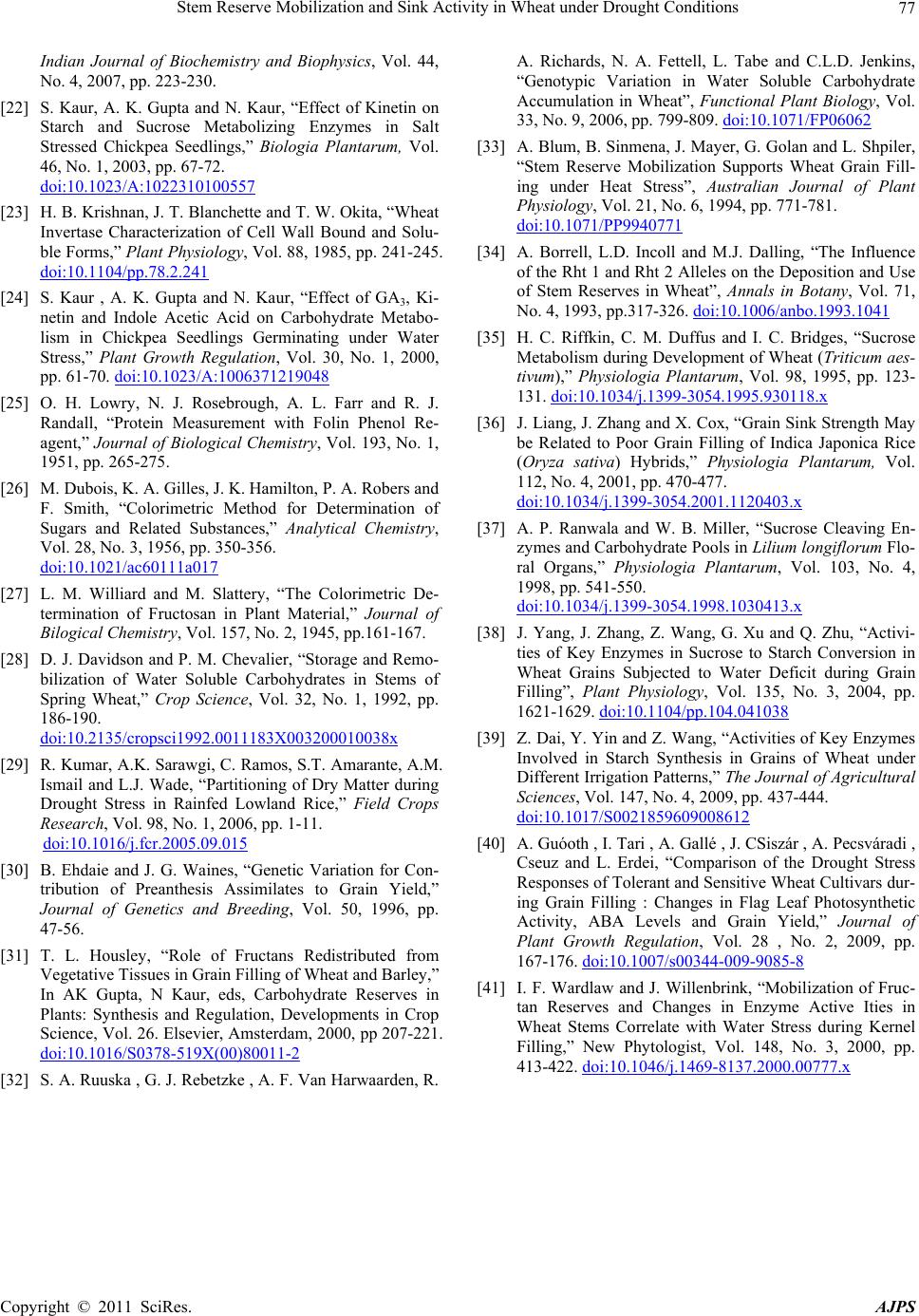 Stem Reserve Mobilization and Sink Activity in Wheat under Drought Conditions Copyright © 2011 SciRes. AJPS 77 Indian Journal of Biochemistry and Biophysics, Vol. 44, No. 4, 2007, pp. 223-230. [22] S. Kaur, A. K. Gupta and N. Kaur, “Effect of Kinetin on Starch and Sucrose Metabolizing Enzymes in Salt Stressed Chickpea Seedlings,” Biologia Plantarum, Vol. 46, No. 1, 2003, pp. 67-72. doi:10.1023/A:1022310100557 [23] H. B. Krishnan, J. T. Blanchette and T. W. Okita, “Wheat Invertase Characterization of Cell Wall Bound and Solu- ble Forms,” Plant Physiology, Vol. 88, 1985, pp. 241-245. doi:10.1104/pp.78.2.241 [24] S. Kaur , A. K. Gupta and N. Kaur, “Effect of GA3, Ki- netin and Indole Acetic Acid on Carbohydrate Metabo- lism in Chickpea Seedlings Germinating under Water Stress,” Plant Growth Regulation, Vol. 30, No. 1, 2000, pp. 61-70. doi:10.1023/A:1006371219048 [25] O. H. Lowry, N. J. Rosebrough, A. L. Farr and R. J. Randall, “Protein Measurement with Folin Phenol Re- agent,” Journal of Biological Chemistry, Vol. 193, No. 1, 1951, pp. 265-275. [26] M. Dubois, K. A. Gilles, J. K. Hamilton, P. A. Robers and F. Smith, “Colorimetric Method for Determination of Sugars and Related Substances,” Analytical Chemistry, Vol. 28, No. 3, 1956, pp. 350-356. doi:10.1021/ac60111a017 [27] L. M. Williard and M. Slattery, “The Colorimetric De- termination of Fructosan in Plant Material,” Journal of Bilogical Chemistry, Vol. 157, No. 2, 1945, pp.161-167. [28] D. J. Davidson and P. M. Chevalier, “Storage and Remo- bilization of Water Soluble Carbohydrates in Stems of Spring Wheat,” Crop Science, Vol. 32, No. 1, 1992, pp. 186-190. doi:10.2135/cropsci1992.0011183X003200010038x [29] R. Kumar, A.K. Sarawgi, C. Ramos, S.T. Amarante, A.M. Ismail and L.J. Wade, “Partitioning of Dry Matter during Drought Stress in Rainfed Lowland Rice,” Field Crops Research, Vol. 98, No. 1, 2006, pp. 1-11. doi:10.1016/j.fcr.2005.09.015 [30] B. Ehdaie and J. G. Waines, “Genetic Variation for Con- tribution of Preanthesis Assimilates to Grain Yield,” Journal of Genetics and Breeding, Vol. 50, 1996, pp. 47-56. [31] T. L. Housley, “Role of Fructans Redistributed from Vegetative Tissues in Grain Filling of Wheat and Barley,” In AK Gupta, N Kaur, eds, Carbohydrate Reserves in Plants: Synthesis and Regulation, Developments in Crop Science, Vol. 26. Elsevier, Amsterdam, 2000, pp 207-221. doi:10.1016/S0378-519X(00)80011-2 [32] S. A. Ruuska , G. J. Rebetzke , A. F. Van Harwaarden, R. A. Richards, N. A. Fettell, L. Tabe and C.L.D. Jenkins, “Genotypic Variation in Water Soluble Carbohydrate Accumulation in Wheat”, Functional Plant Biology, Vol. 33, No. 9, 2006, pp. 799-809. doi:10.1071/FP06062 [33] A. Blum, B. Sinmena, J. Mayer, G. Golan and L. Shpiler, “Stem Reserve Mobilization Supports Wheat Grain Fill- ing under Heat Stress”, Australian Journal of Plant Physiology, Vol. 21, No. 6, 1994, pp. 771-781. doi:10.1071/PP9940771 [34] A. Borrell, L.D. Incoll and M.J. Dalling, “The Influence of the Rht 1 and Rht 2 Alleles on the Deposition and Use of Stem Reserves in Wheat”, Annals in Botany, Vol. 71, No. 4, 1993, pp.317-326. doi:10.1006/anbo.1993.1041 [35] H. C. Riffkin, C. M. Duffus and I. C. Bridges, “Sucrose Metabolism during Development of Wheat (Triticum aes- tivum),” Physiologia Plantarum, Vol. 98, 1995, pp. 123- 131. doi:10.1034/j.1399-3054.1995.930118.x [36] J. Liang, J. Zhang and X. Cox, “Grain Sink Strength May be Related to Poor Grain Filling of Indica Japonica Rice (Oryza sativa) Hybrids,” Physiologia Plantarum, Vol. 112, No. 4, 2001, pp. 470-477. doi:10.1034/j.1399-3054.2001.1120403.x [37] A. P. Ranwala and W. B. Miller, “Sucrose Cleaving En- zymes and Carbohydrate Pools in Lilium longiflorum Flo- ral Organs,” Physiologia Plantarum, Vol. 103, No. 4, 1998, pp. 541-550. doi:10.1034/j.1399-3054.1998.1030413.x [38] J. Yang, J. Zhang, Z. Wang, G. Xu and Q. Zhu, “Activi- ties of Key Enzymes in Sucrose to Starch Conversion in Wheat Grains Subjected to Water Deficit during Grain Filling”, Plant Physiology, Vol. 135, No. 3, 2004, pp. 1621-1629. doi:10.1104/pp.104.041038 [39] Z. Dai, Y. Yin and Z. Wang, “Activities of Key Enzymes Involved in Starch Synthesis in Grains of Wheat under Different Irrigation Patterns,” The Journal of Agricultural Sciences, Vol. 147, No. 4, 2009, pp. 437-444. doi:10.1017/S0021859609008612 [40] A. Guóoth , I. Tari , A. Gallé , J. CSiszár , A. Pecsváradi , Cseuz and L. Erdei, “Comparison of the Drought Stress Responses of Tolerant and Sensitive Wheat Cultivars dur- ing Grain Filling : Changes in Flag Leaf Photosynthetic Activity, ABA Levels and Grain Yield,” Journal of Plant Growth Regulation, Vol. 28 , No. 2, 2009, pp. 167-176. doi:10.1007/s00344-009-9085-8 [41] I. F. Wardlaw and J. Willenbrink, “Mobilization of Fruc- tan Reserves and Changes in Enzyme Active Ities in Wheat Stems Correlate with Water Stress during Kernel Filling,” New Phytologist, Vol. 148, No. 3, 2000, pp. 413-422. doi:10.1046/j.1469-8137.2000.00777.x |

